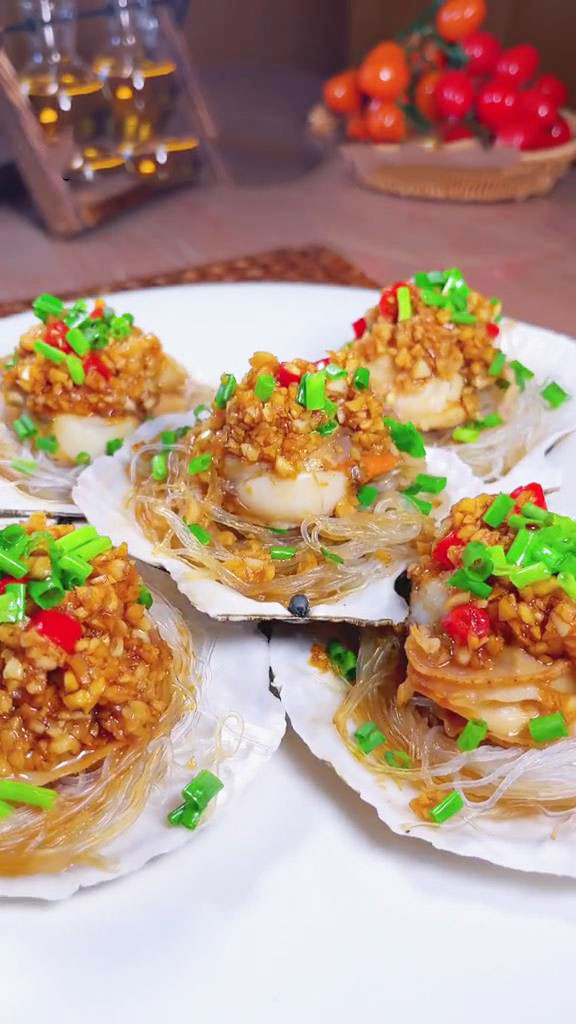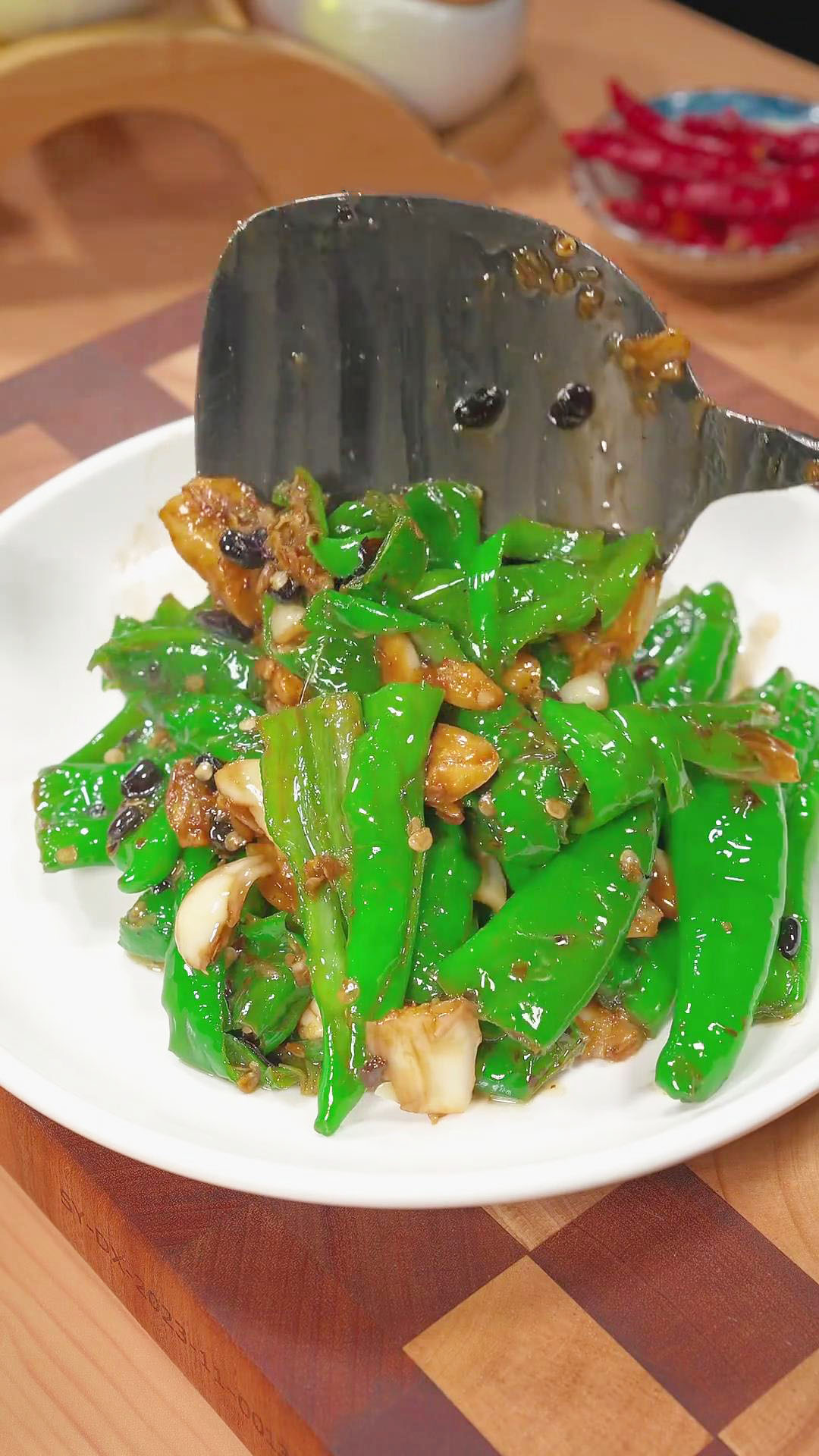This post may contain affiliate links. Please read our disclosure policy.
It’s simple but made incredibly delicious with pantry-friendly ingredients. Chinese-style braised daikon radish is packed with umami and hints of licorice-like taste. Whip this up in 30 minutes and serve it as your entree, side dish, or garnish.
Why Braising Daikon Radish Is Better
Braising is a popular cooking method that uses a slow simmer process. It is a combination of frying the food first before simmering with a small amount of water on medium-low heat. This technique gives the daikon a nice brown finish and a soft, buttery texture.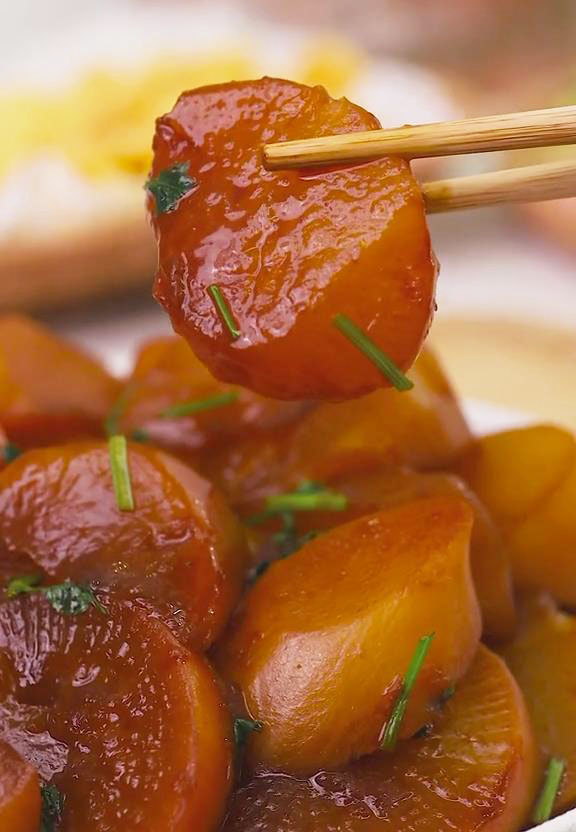
A medium-low and gentle simmer helps extract the natural flavors of the daikon as it absorbs the flavors of the seasonings. In this recipe, I braised the daikon radish with light soy sauce, dark soy sauce, oyster sauce, and star anise. The seasonings are diluted in half a pot of water before simmering for 25 minutes.
The result? A savory, umami braised daikon radish with a hint of licorice. Serve this dish at any time of the day as your main meal or side dish. Pair it with other braised dishes, such as Red Braised Pig Trotter (Pigs Feet). Check out these additional easy vegetable dishes if you’re looking for more:
- Blanched Bok Choy With Vegetable Sauce
- Eggplant And Minced Pork
- Stir-Fried Yu Choy
- Sautéed Okra and Egg
- Boiled Okra With Spicy Savory Sauce
- Steamed Cabbage Rolls In Savory Sauce
- Bok Choy With Savory Oyster Sauce
- Stir-Fried Bok Choy And Mushrooms
Ingredient Tips And Alternatives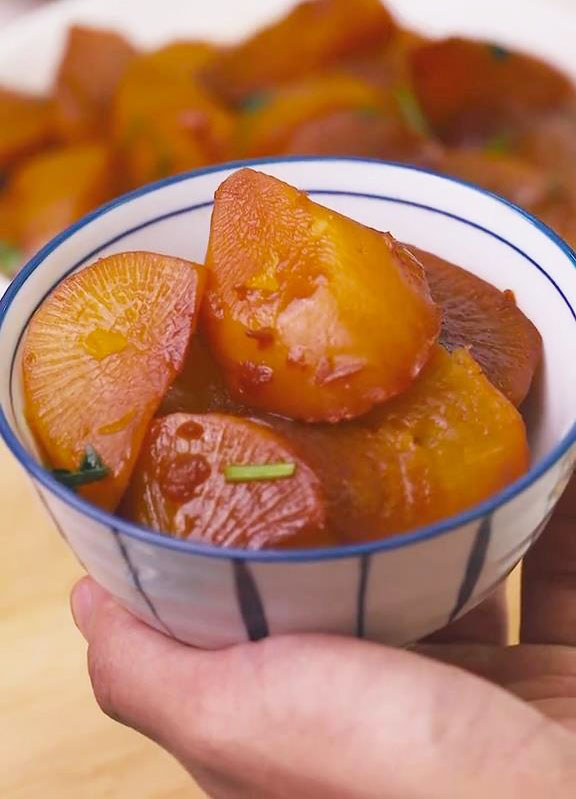
Before starting with the recipe steps, read my top ingredient tips and alternatives here. I share below how each ingredient contributes to the dish and how to substitute them with the best alternative.
- Daikon radish: I love daikon for its natural sweetness and subtle peppery taste. When choosing a daikon, pick the one with bright green leaves and white skin. The surface should be firm, smooth, and thick. Moreover, it should feel heavy and have a straight appearance. Use a large daikon radish, peel, and slice it according to your desired shape. Using a vegetable peeler is the easiest way to peel off the thick skin of daikon. You can slice it into rounds, half moons, quarter rounds, or diced. Any shape will do, as long as they have the same thickness to cook them consistently. Otherwise, you may end up with different textures, making some tender while some too soft.
- Oil for frying: Any cooking oil for frying will do. Use olive, avocado, sesame, or safflower oil if you prefer a healthier type of oil. If you are looking for a neutral-tasting oil, go for peanut, soybean, or vegetable oil. For oils with a high smoke point, use avocado oil, peanut, canola, or corn oil.
- Light soy sauce:Sometimes, when a dish is a little bit bland, soy sauce is the only solution. Its salty and umami flavors deepen the overall taste of a dish. You can also use tamari, liquid aminos, coconut aminos, or gluten-free soy sauce.
- Dark soy sauce: If light soy sauce deepens the flavor, dark soy sauce is the one that deepens the color. Dark soy sauce is a go-to ingredient for braising and marinating dishes since it darkens the color of the dish with its thick and dark consistency. As for the taste, it is umami and typically sweeter than light soy sauce. It is perfectly fine to omit this from the recipe if you don’t have dark soy sauce. If you want to replace it with the closest substitute, swap it with mushroom sauce, double black soy sauce, teriyaki sauce, or more oyster sauce and adjust to taste.
- Oyster sauce: For extra umaminess, I added a bit of oyster sauce as well. Oyster sauce tastes like a combination of soy sauce and barbecue sauce. It is sweet and savory with notes of caramel. You can swap this with hoisin sauce, teriyaki sauce, kecap manis, Worcestershire sauce with soy sauce and sugar, or oyster-flavored sauce.
- Star anise: Star anise is a special ingredient well known for its licorice-like taste and strong aroma. It adds a warm, woody, and sweet taste to the dish. This star-shaped spice can be substituted with anise seeds, Chinese five spice, allspice, fennel seeds, and cloves. However, the taste won’t be exactly the same, so make sure to adjust the taste. If you want to learn more about each star anise alternative, read my in-depth guide on Top 5 Star Anise Substitutes.
- Water: To complete the simmering method, the seasonings are diluted in a small amount of water. I used about 1/2 pot of water. Aside from water, you can add more flavor by swapping it with chicken stock, vegetable stock, dashi stock, bouillon powder, or cubes.
- Coriander: Adding fresh coriander leaves as a garnish is great for decoration and a boost of flavor. It is best for imparting a tart and lemon-like taste. Use fresh coriander leaves and roughly chop them. You can swap fresh coriander with other chopped herbs or vegetables, such as dill, parsley, mint, scallion, cilantro, or basil.
- Optional flavoring ingredients: If you want to experiment and adjust the taste of the dish, here are some excellent flavoring ingredients to incorporate:
- Ginger: Ginger imparts a peppery taste and a refreshing aroma. You can use fresh ginger or ginger powder and add this to the frying step.
- Green onions: You can add chopped green onions in the frying step or use it as a garnish in the end. This adds color and a subtle sweet oniony taste to the daikons.
- Sweet soybean paste: You may also know sweet soybean paste as broad bean paste or doubanjiang. It lends a distinct sweet and spicy flavor. Since it is made from fermented soybeans, it also imparts a nutty and funky taste.
- Cooking wine: Use cooking wine, such as Shaoxing rice wine, sake, mirin, or alcohol-free wine, to add a sweet and briny taste.
- Sugar: Adjust the salty flavors with a bit of sugar. You can use any type of sweetener, including white sugar, cane sugar, brown sugar, maple syrup, or coconut sugar.
- Cornstarch slurry: The sauce of the dish is runny and thin. If you want to change the consistency of the sauce, you can make it creamy and thick with cornstarch. Make a cornstarch water slurry and add it by the end of the simmering step. Mix 1 tbsp of cornstarch with 2 tbsp of water (1:2 ratio). If you don’t have cornstarch, you can substitute 1 tbsp of cornstarch with 2 tbsp of tapioca flour or 1 tbsp of potato starch.
- Mushroom powder: Mushroom powder just makes everything better. It is a flexible seasoning that goes with almost any dish, lending an earthy and umami taste.
- Japanese flavors: If you want to incorporate all Japanese flavors, you can use shoyu or Japanese soy sauce, Japanese cooking sake, and dashi stock.
Ingredients And Kitchenware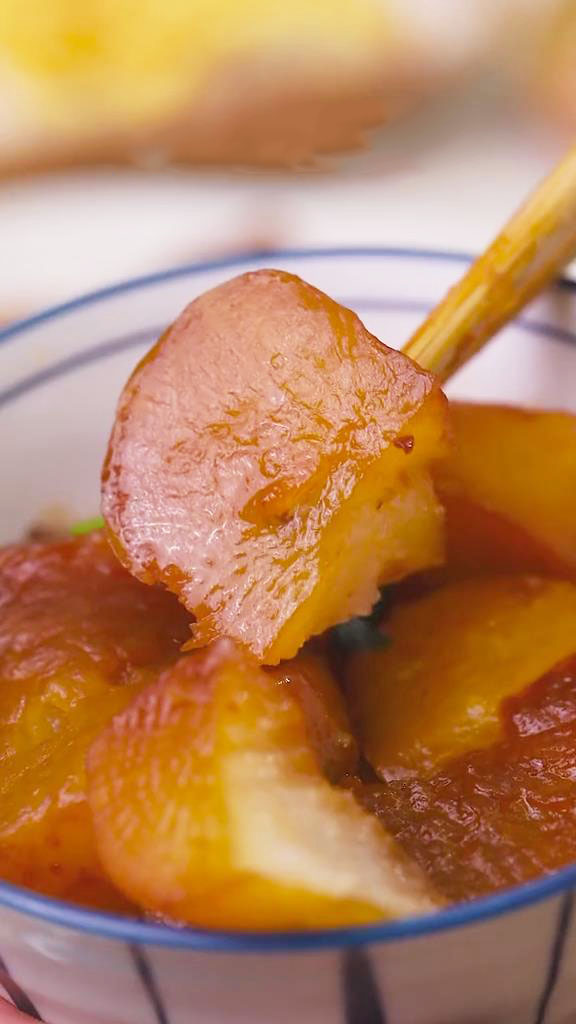
Prepare a knife for chopping, a vegetable peeler for peeling the skin, and a non-stick pan with a lid for frying and simmering. I prefer using a non-stick pan to reduce the risk of burning and sticking. Here are the ingredients to prepare:
- 1 large daikon radish (peeled and sliced)
- 1 tbsp Oil for frying
- 2 tbsp light soy sauce
- 2 tbsp dark soy sauce
- 1 tbsp oyster sauce
- 2 pieces star anise
- 1/2 pot water
- Chopped fresh coriander (optional for garnish)
5 Steps To Make Chinese-Style Braised Daikon Radish
Once all the ingredients are ready, the simmering step just takes 25 minutes to finish. Check out my 20-second tutorial video on Instagram or TikTok to learn more about the steps. When you are done making this dish, don’t forget to snap a photo and tag me @kitchenmisadventures.
- Start by washing and peeling the daikon radish. Slice it into your desired shape and thickness. I use a method called the “Roll Cut,” where you make a 45-degree angle cut, then rotate the radish 90 degrees and make another cut. I prefer larger chunks to prevent them from cooking too quickly and melting.

- Heat oil in the pan and stir-fry the daikon radish for about a minute. Then, season with light soy sauce, dark soy sauce, and oyster sauce. Mix the sauce well until the daikon is evenly coated.
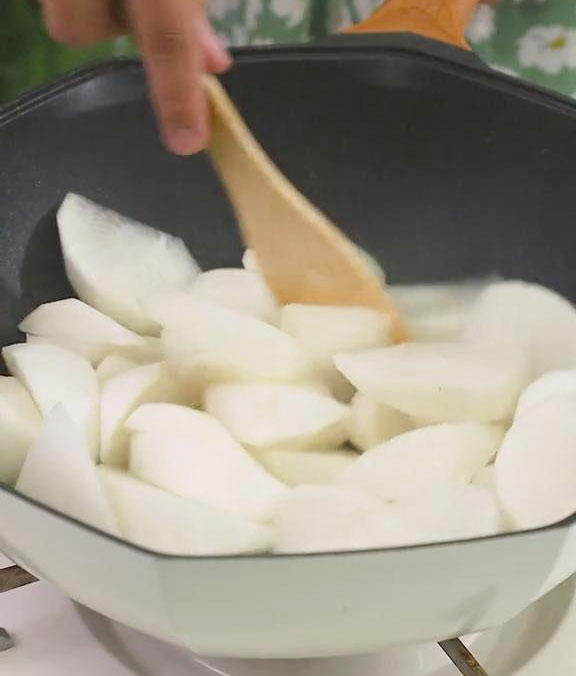
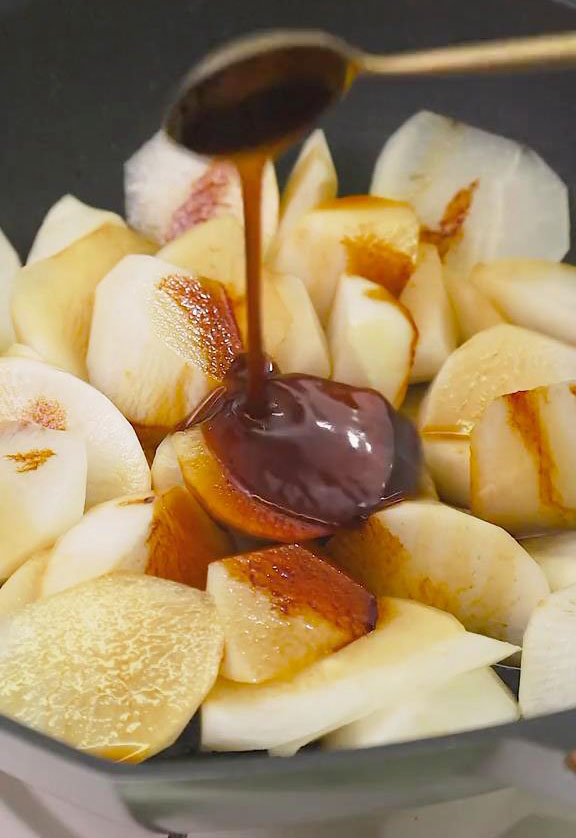
- Stir-fry for another minute and add star anise and half a pot of water. Adjust the water quantity based on your pot size; avoid adding too much as it can prolong the evaporation process.
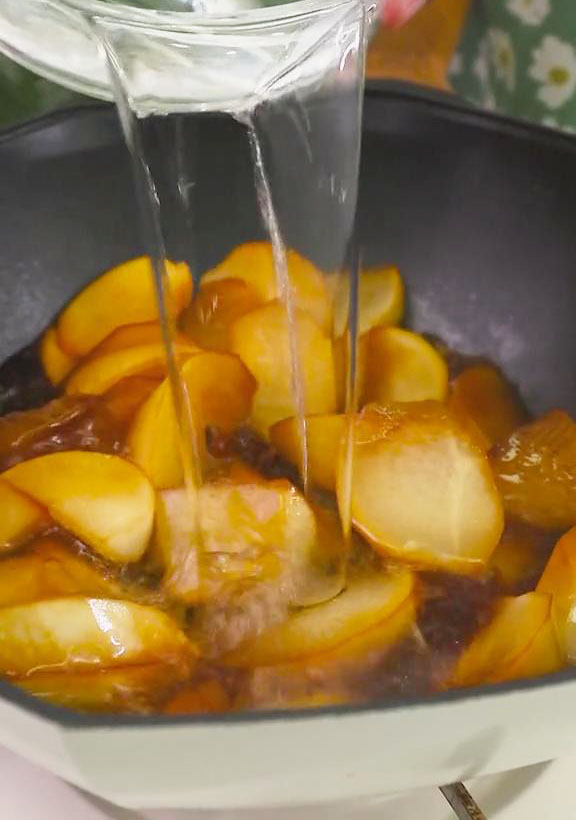
- Cover the pan with a lid and let it simmer for 25 minutes to bring out the flavors. In this step, it is crucial to check the amount of sauce constantly. There should be enough sauce left to avoid burning the daikon radish. If no sauce is left, add a bit of water as needed. If you have added too much water, you can turn the heat up to let it evaporate and thicken.
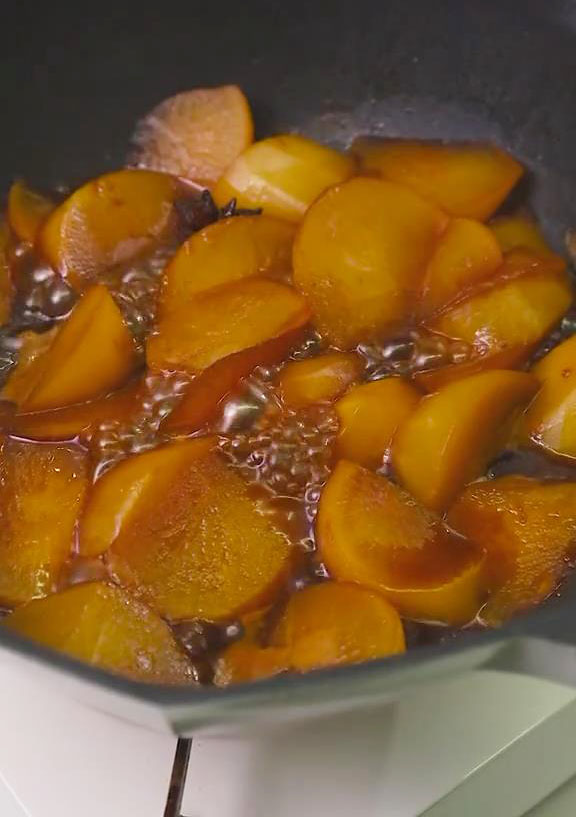
- After 25 minutes, turn off the heat and garnish with chopped fresh coriander. Set aside for a few minutes to ensure maximum flavor absorption. The daikon radish should have a tender texture and deep brown color.
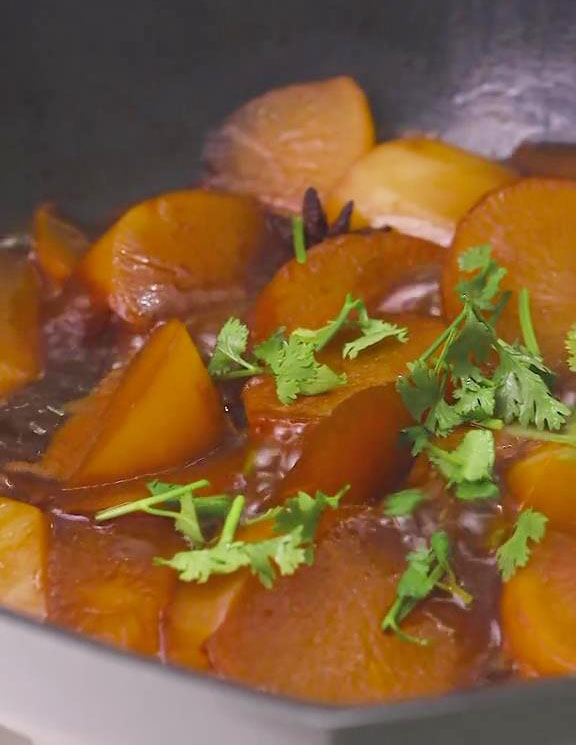
Enjoy Chinese-style braised daikon radish on its own or with hot white rice. Store it in an airtight container in the fridge for up to 3 days. To reheat, add a bit of water to thin out the sauce and reheat in the microwave or pan.
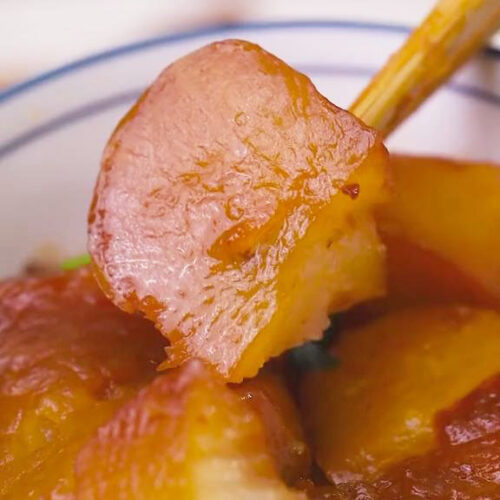
Braised Daikon Radish (5 Easy Steps!)
Ingredients
- 1 large daikon radish peeled and sliced
- 1 tbsp Oil for frying
- 2 tbsp light soy sauce
- 2 tbsp dark soy sauce
- 1 tbsp oyster sauce
- 2 pieces star anise
- 1/2 pot of water
- Chopped fresh coriander optional for garnish
Instructions
- Start by washing and peeling the daikon radish. Slice it into your desired shape and thickness. I use a method called the "Roll Cut," where you make a 45-degree angle cut, then rotate the radish 90 degrees and make another cut. I prefer larger chunks to prevent them from cooking too quickly and melting.
- Heat oil in the pan and stir-fry the daikon radish for about a minute. Then, season with light soy sauce, dark soy sauce, and oyster sauce. Mix the sauce well until the daikon is evenly coated.
- Stir-fry for another minute and add star anise and half a pot of water. Adjust the water quantity based on your pot size; avoid adding too much as it can prolong the evaporation process.
- Cover the pan with a lid and let it simmer for 25 minutes to bring out the flavors. In this step, it is crucial to check the amount of sauce constantly. There should be enough sauce left to avoid burning the daikon radish. If no sauce is left, add a bit of water as needed. If you have added too much water, you can turn the heat up to let it evaporate and thicken.
- After 25 minutes, turn off the heat and garnish with chopped fresh coriander. Set aside for a few minutes to ensure maximum flavor absorption. The daikon radish should have a tender texture and deep brown color.

